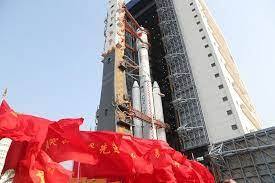The Long March-7 Y8 carrier rocket, tasked with sending China's space station cargo craft Tianzhou-7 into orbit, was transported to the Wenchang Spacecraft Launch Site in the southern province of Hainan on Thursday.
The rocket will undergo assembly and testing together with Tianzhou-7, which arrived earlier, the China Manned Space Agency said on Thursday.
At present, all testing systems at the launch site are gearing up for the launch as planned, the agency confirmed.
This photo taken on Jan. 15, 2024 shows the combination of the Tianzhou-7 cargo spacecraft and a Long March-7 Y8 carrier rocket being transferred at Wenchang Spacecraft Launch Site in south China's Hainan Province. The combination of the Tianzhou-7 cargo spacecraft and a Long March-7 Y8 carrier rocket was vertically transferred to the launching area on Monday.
The cargo spacecraft will be launched in the near future at an appropriate time, according to the China Manned Space Agency.
The facilities and equipment at the Wenchang Spacecraft Launch Site are all in good condition, and various pre-launch function checks and joint tests will be carried out as planned, the agency said in a statement. (Photo by Hu Xujie/Xinhua)
The combination of the Tianzhou-7 cargo spacecraft and a Long March-7 Y8 carrier rocket was vertically transferred to the launching area on Monday.
The cargo spacecraft will be launched in the near future at an appropriate time, according to the China Manned Space Agency.
The facilities and equipment at the Wenchang Spacecraft Launch Site in China's southern island province of Hainan are all in good condition, and various pre-launch function checks and joint tests will be carried out as planned, the agency said in a statement.
This photo taken on Jan. 15, 2024 shows the combination of the Tianzhou-7 cargo spacecraft and a Long March-7 Y8 carrier rocket being transferred at Wenchang Spacecraft Launch Site in south China's Hainan Province. The combination of the Tianzhou-7 cargo spacecraft and a Long March-7 Y8 carrier rocket was vertically transferred to the launching area on Monday.
The cargo spacecraft will be launched in the near future at an appropriate time, according to the China Manned Space Agency.
The facilities and equipment at the Wenchang Spacecraft Launch Site are all in good condition, and various pre-launch function checks and joint tests will be carried out as planned, the agency said in a statement. (Photo by Hu Xujie/Xinhua)
The Tianzhou 7 freighter is carrying fresh fruit, vegetables and surprises for China's astronauts.
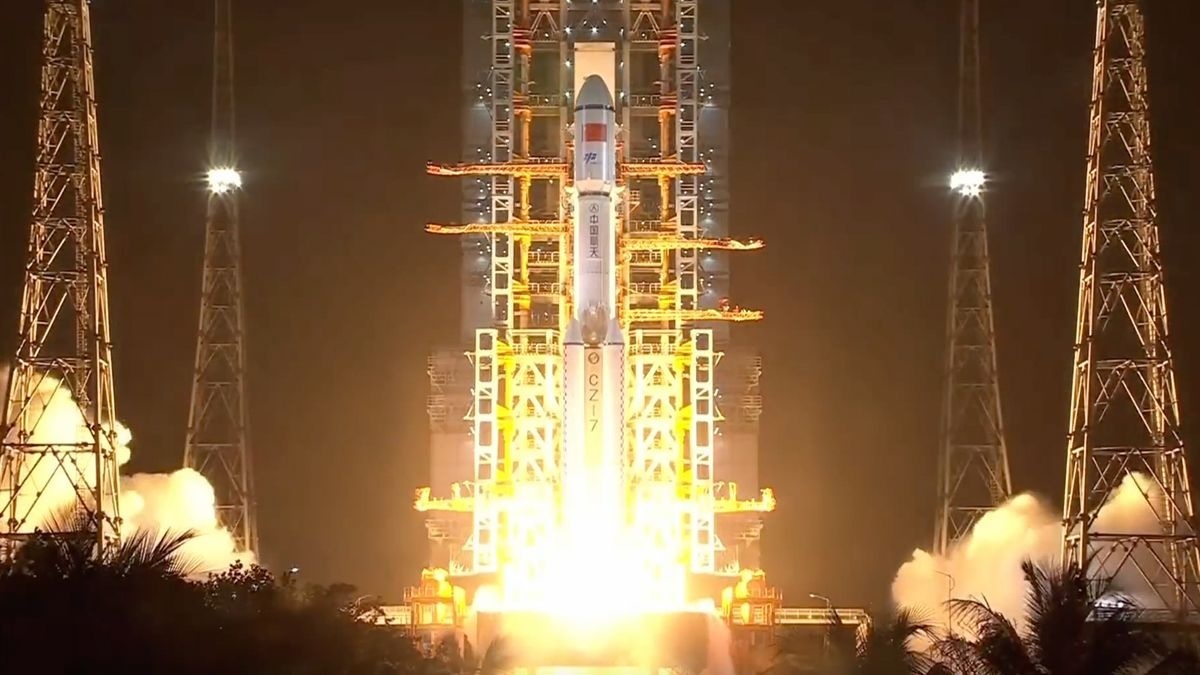
China has launched its first space station mission of the year to resupply the orbital outpost.
A Long March 7 rocket topped with the robotic Tianzhou 7 cargo spacecraft lifted off from Wenchang Satellite Launch Center on Hainan island in the South China Sea on Wednesday (Jan. 17) at 9:27 a.m. EST (1427 GMT; 10:27 p.m. Beijing time).
Tianzhou 7 is planned to rendezvous and dock with China's three-module Tiangong space station around three hours after launch. The three crewmembers of the Shenzhou 17 mission onboard Tiangong will oversee the freighter's arrival and later begin sorting through its cargo.
China's Tianzhou spacecraft have recently been upgraded, allowing the 29,760-pound (13,500 kilograms) spacecraft to carry around 16,300 pounds (7,400 kg) of cargo to Tiangong. This improvement means China needs to launch a resupply mission once every eight months instead of once every six months.
Tianzhou spacecraft haul supplies, propellant, scientific experiments and equipment to Tiangong. On this mission, the cargo also includes surprises for the upcoming Chinese New Year celebrations, as well as some fresh fruit and vegetables.
"There will be a further increase in the quantity and weight of fresh fruits we are to deliver this time, which should continuously improve the quality of astronauts' life in orbit," Yang Sheng, development technician of the China Aerospace Science and Technology Corporation (CASC), told CCTV ahead of launch.
Tianzhou 7 carries supplies for both Shenzhou 17, which arrived at Tiangong in late October, and for the coming Shenzhou 18 mission. Chinese crewed missions to the space station typically last six months.
The previous cargo mission, Tianzhou 6, launched in May of last year. That spacecraft undocked from Tiangong on Jan. 12, making way for the arrival of Tianzhou 7.
Tianzhou 6 is now in free flight mode and will be deorbited in a controlled manner in the near future. Having first delivered supplies to Tiangong, it is now being used to dispose of space station waste.
Tianzhou 8 will launch around August to resupply Tiangong once more. China will launch the Shenzhou 18 and 19 crewed missions in 2024, meaning it will send a total of four spacecraft to Tiangong this year.
Quelle: SC
+++
China Focus: China launches new cargo craft to send space station supplies
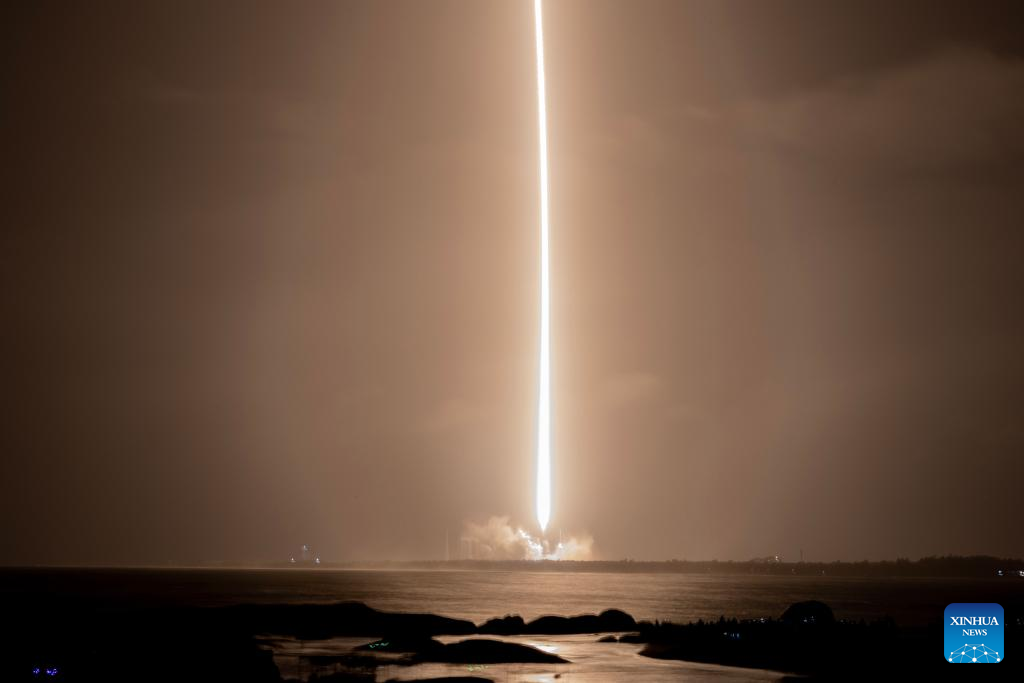
A Long March-7 Y8 carrier rocket carrying cargo spacecraft Tianzhou-7 blasts off from the Wenchang Spacecraft Launch Site in south China's Hainan Province, Jan. 17, 2024. (Xinhua/Liu Jinhai)
China launched cargo spacecraft Tianzhou-7 on Wednesday night to deliver supplies for its orbiting Tiangong space station, according to the China Manned Space Agency (CMSA).
The Long March-7 Y8 rocket, carrying Tianzhou-7, blasted off at 10:27 p.m. (Beijing Time) from the Wenchang Spacecraft Launch Site in the southern island province of Hainan, the CMSA said.
After about 10 minutes, Tianzhou-7 separated from the rocket and entered its designated orbit. Its solar panels soon unfolded. The agency declared the launch a complete success.
Wednesday's launch is the first mission of China's manned space project this year. It is also the 507th mission of the Long March rocket series.
The mission is the sixth flight of the space station cargo delivery system consisting of the Tianzhou cargo craft and the Long March-7 carrier rocket.
The cargo craft and launch vehicle were respectively developed by the China Academy of Space Technology (CAST) and the China Academy of Launch Vehicle Technology, both of which are affiliated with the China Aerospace Science and Technology Corporation.
Tianzhou-7 will take three hours for the rendezvous and docking with the space station. Previous Tianzhou missions regularly took about 6.5 hours in rendezvous and docking. The exception was the Tianzhou-5 mission, which only took about two hours.
Tianzhou-7 will adopt a new mode of rendezvous and docking yet to be verified in orbit, which is expected to give better play to the guidance, navigation, and control systems of the spacecraft, according to Li Zhiyong, a researcher at the CAST.
Tianzhou-7 is the seventh cargo craft developed by the CAST. "As an improved fully-sealed cargo craft, it has the largest cargo transport capacity, the highest cargo-delivery efficiency, and the most complete in-orbit support capability in the world," said Li.
Tianzhou-7 carries more than 260 items of supplies, including those for the astronaut system, space station system, application tasks, and cargo spacecraft system, as well as other engineering goods, featuring a variety of cargo and large-sized items. The total weight of onboard materials reached about 5.6 tonnes.
Customized cargo packages for experiment payloads and other large-scale goods, each weighing over 100 kilograms, will be applied in the operation of the space station, space science experiments, and astronaut life support.
Tianzhou-7 also sends 2,400 kilograms of living supplies for the astronauts, including Lunar New Year goods and fresh fruits and vegetables. The packaging design has been optimized to ensure longer storage time and freshness.
The application system has loaded Tianzhou-7 with a total of 61 items weighing 473 kilograms, including experiment payloads, experiment units and samples, consumable items, and spare parts, to support continuous space experiments, according to Liu Wei, a researcher at the Technology and Engineering Center for Space Utilization under the Chinese Academy of Sciences.
The items also contain a set of life support devices to keep cell samples in good condition during this mission and a set of microfluidic chips with the temperature kept at 4 degrees Celsius, said Liu.
Those items will be transferred to the space station's experiment facility to carry out a total of 33 scientific experiments, such as the effect of space microgravity on human bone cells, the propellant fluid transport and stability under variable gravity, and the growth of nano precious metals in solution under microgravity. The experiments cover fields such as space life science, space material science, microgravity fluid physics, and combustion science, Liu added.
According to the plan, China will launch the Tianzhou-8 cargo spacecraft from the Wenchang Spacecraft Launch Site this year. The site is the country's fourth launch site and the only one by the seaside.
Quelle: Xinhua
+++
China's cargo craft Tianzhou-7 docks with space station combination

This screen image captured at Beijing Aerospace Control Center on Jan. 18, 2024 shows China's cargo spacecraft Tianzhou-7 approaching the combination of the space station Tiangong before docking.
China's cargo craft Tianzhou-7 completed its status setting and docked with the orbiting Tiangong space station on Thursday, the China Manned Space Agency (CMSA) said.
At 1:46 a.m. (Beijing Time), Tianzhou-7 docked at the rear docking port of the Tianhe core module, said the CMSA.
The Shenzhou-17 crew members onboard the space station will enter the cargo craft and transfer the payloads as scheduled. (Xinhua/Li Jie)
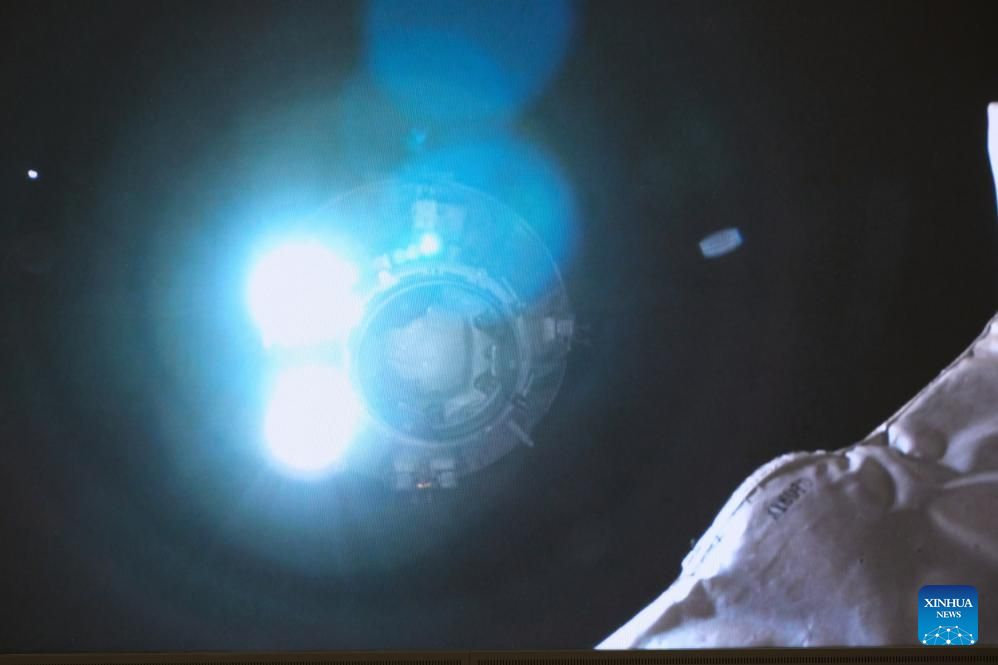
This screen image captured at Beijing Aerospace Control Center on Jan. 18, 2024 shows China's cargo spacecraft Tianzhou-7 approaching the combination of the space station Tiangong before docking.
China's cargo craft Tianzhou-7 completed its status setting and docked with the orbiting Tiangong space station on Thursday, the China Manned Space Agency (CMSA) said.
At 1:46 a.m. (Beijing Time), Tianzhou-7 docked at the rear docking port of the Tianhe core module, said the CMSA.
The Shenzhou-17 crew members onboard the space station will enter the cargo craft and transfer the payloads as scheduled. (Xinhua/Li Jie)
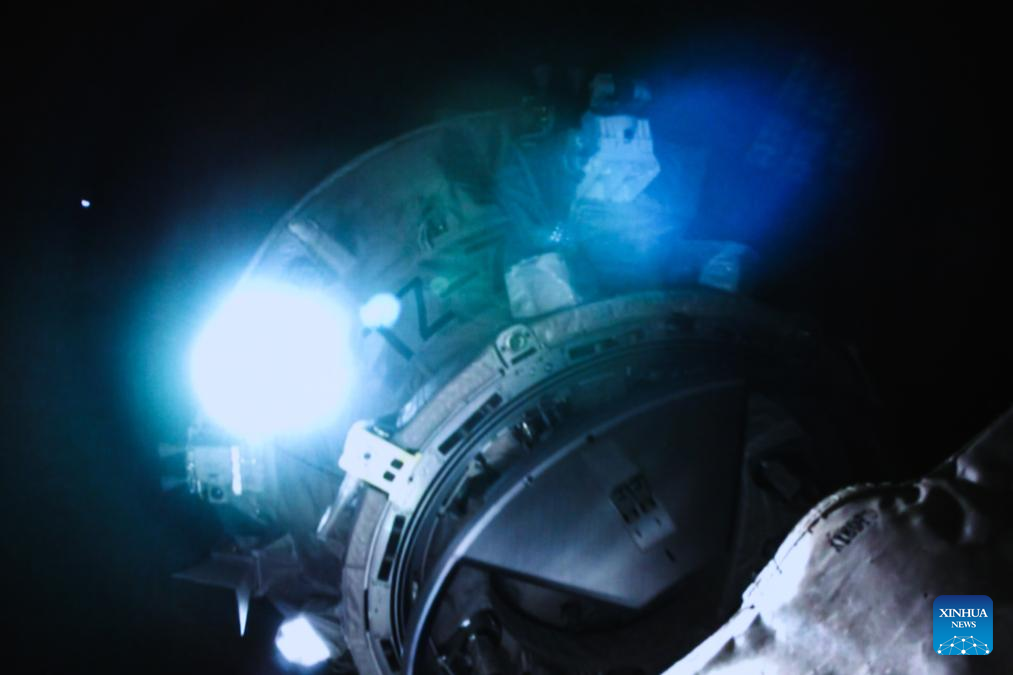
This screen image captured at Beijing Aerospace Control Center on Jan. 18, 2024 shows China's cargo spacecraft Tianzhou-7 approaching the combination of the space station Tiangong before docking.
China's cargo craft Tianzhou-7 completed its status setting and docked with the orbiting Tiangong space station on Thursday, the China Manned Space Agency (CMSA) said.
At 1:46 a.m. (Beijing Time), Tianzhou-7 docked at the rear docking port of the Tianhe core module, said the CMSA.
The Shenzhou-17 crew members onboard the space station will enter the cargo craft and transfer the payloads as scheduled. (Photo by Han Qiyang/Xinhua)
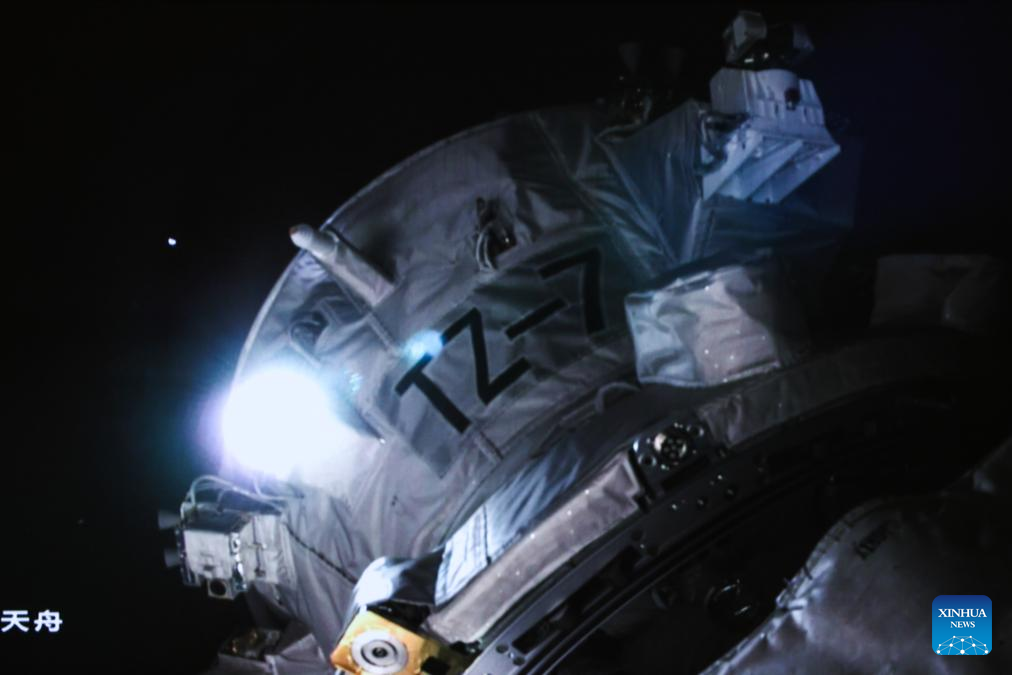
This screen image captured at Beijing Aerospace Control Center on Jan. 18, 2024 shows China's cargo spacecraft Tianzhou-7 docking with the combination of the space station Tiangong.
China's cargo craft Tianzhou-7 completed its status setting and docked with the orbiting Tiangong space station on Thursday, the China Manned Space Agency (CMSA) said.
At 1:46 a.m. (Beijing Time), Tianzhou-7 docked at the rear docking port of the Tianhe core module, said the CMSA.
The Shenzhou-17 crew members onboard the space station will enter the cargo craft and transfer the payloads as scheduled. (Photo by Han Qiyang/Xinhua)
Quelle: Xinhua
